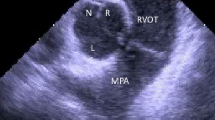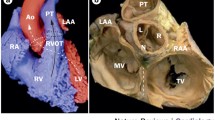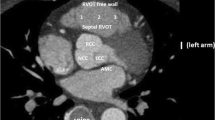Abstract
Purpose
Idiopathic outflow tract ventricular arrhythmias are ventricular tachycardias or premature ventricular contractions presumably not related to myocardial scar or disorders of ion channels. These arrhythmias have focal origin and display characteristic electrocardiographic features. The purpose of this article is to review the state of the art of diagnosis and treatment of idiopathic outflow tract ventricular arrhythmias.
Methods
We systematically reviewed scientific literature about idiopathic outflow tract ventricular arrhythmias selecting the most relevant papers on this topic.
Results
The right ventricle outflow tract is the most common site of origin for outflow tract ventricular arrhythmias, but also left ventricle outflow tract can harbour these arrhythmias. Outflow tract ventricular arrhythmias are generally benign and may require treatment if they are symptomatic, incessant or give rise to cardiomyopathy. Radiofrequency catheter ablation is an effective and safe therapeutic strategy. A successful procedure requires a thorough preoperative analysis of the 12-lead electrocardiogram of the spontaneous arrhythmia combined with a detailed electroanatomical mapping and intracardiac echocardiography.
Conclusions
Idiopathic outflow tract arrhythmias are frequent in daily clinical practice and can be successfully eliminated through discrete radiofrequency catheter ablation with low rates of complications.








Similar content being viewed by others
Abbreviations
- OT:
-
outflow tract
- VA:
-
ventricular arrhythmia
- RVOT:
-
right ventricle outflow tract
- LVOT:
-
left ventricle outflow tract
- RFCA:
-
radiofrequency catheter ablation
- PVC:
-
premature ventricular contraction
- LBBB:
-
left bundle branch block
- RBBB:
-
right bundle branch block
- ECG:
-
electrocardiogram
References
Kim RJ, Iwai S, Markowitz SM, Shah BK, Stein KM, Lerman BB. Clinical and electrophysiological spectrum of idiopathic ventricular outflow tract arrhythmias. J Am Coll Cardiol. 2007;49(20):2035–43.
Yamada T. Idiopathic ventricular arrhythmias: relevance to the anatomy, diagnosis and treatment. J Cardiol. 2016;68(6):463–71.
Kumagai K. Idiopathic ventricular arrhythmias arising from the left ventricular outflow tract: tips and tricks. J Arrhythmia. 2014;30(4):211–21.
Yamada T, Doppalapudi H, McElderry HT, Okada T, Murakami Y, Inden Y, et al. Idiopathic ventricular arrhythmias originating from the papillary muscles in the left ventricle: prevalence, electrocardiographic and electrophysiological characteristics, and results of the radiofrequency catheter ablation. J Cardiovasc Electrophysiol. 2010;21:62–9.
Crawford T, Mueller G, Good E, Jongnarangsin K, Chugh A, Pelosi F Jr, et al. Ventricular arrhythmias originating from papillary muscles in the right ventricle. Heart Rhythm. 2010;7(6):725–30.
Sadek MM, Benhayon D, Sureddi R, Chik WM, Santangeli P, Supple GE, et al. Idiopathic ventricular arrhythmias originating from the moderator band: electrocardiographic characteristics and treatment by catheter ablation. Heart Rhythm. 2015;12(1):67–75.
Dukkipati SR, Choudry S, Koruth JS, Miller MA, Whang W, Reddy VY. Catheter ablation of ventricular tachycardia in structurally normal hearts indications, strategies, and outcomes—part I. J Am Coll Cardiol. 2017;70:2909–23.
Cronin EM, Bogun FM, Maury P, Peichl P, Chen M, Namboodiri N, et al. 2019 HRS/EHRA/APHRS/LAHRS expert consensus statement on catheter ablation of ventricular arrhythmias. Europace. 2019;00:1–147.
Ho SY. Structure and anatomy of the aortic root. Eur J Echocardiogr. 2009;10(1):4–11.
Hutchinson MD, Garcia FC. An organized approach to the localization, mapping, and ablation of outflow tract ventricular arrhythmias. J Cardiovasc Electrophysiol. 2013;24(10):1189–97.
Tanner H, Hindricks G, Schirdewahn P, Kobza R, Dorszewski A, Piorkowski C, et al. Outflow tract tachycardia with R/S transition in lead V3. Six different anatomic approaches for successful ablation. J Am Coll Cardiol. 2005;45:418–23.
Ouyang F, Fotuhi P, Ho SY, Hebe J, Volkmer M, Goya M, et al. Repetitive monomorphic ventricular tachycardia originating from the aortic sinus cusp. J Am Coll Cardiol. 2002;39:500–8.
Yoshida N, Yamada T, McElderry HT, Inden Y, Shimano M, Murohara T, et al. A novel electrocardiographic criterion for differentiating a left from right ventricular outflow tract tachycardia origin: the V2s/V3R index. J Cardiovasc Electrophysiol. 2014;25(7):747–53.
Yoshida N, Inden Y, Uchikawa T, Kamiya H, Kitamura K, Shimano M, et al. Novel transitional zone index allows more accurate differentiation between idiopathic right ventricular outflow tract and aortic sinus cusp ventricular arrhythmias. Heart Rhythm. 2011;8:349–56.
Xie S, Kubala M, Liang JJ, Hayashi T, Park J, Padros IL, et al. Lead I R-wave amplitude to differentiate idiopathic ventricular arrhythmias with left bundle branch block right inferior axis originating from the left versus right ventricular outflow tract. J Cardiovasc Electrophysiol. 2018;29:1515–22.
Anter E, Frankel DS, Marchlinski FE, Dixit S. Effect of electrocardiographic lead placement on localization of outflow tract tachycardias. Heart Rhythm. 2012;9:697–703.
Betensky BP, Park RE, Marchlinski FE, Hutchinson MD, Garcia FC, Dixit S, et al. The V2 transition ratio: a new electrocardiographic criterion for distinguishing left from right ventricular outflow tract tachycardia origin. J Am Coll Cardiol. 2011;57(22):2255–62.
Cheng D, Ju W, Zhu L, Chen K, Zhang F, Chen H, et al. V3R/V7 index. A novel electrocardiographic criterion for differentiating left from right ventricular outflow tract arrhythmias origins. Circ Arrhythm Electrophysiol. 2018;11(11) e006243.
Zhang F, Hamon D, Fang Z, Xu Y, Yang B, Ju W, et al. Value of a posterior electrocardiographic lead for localization of ventricular outflow tract arrhythmias. The V4/V8 ratio. J Am Coll Clin Electrophysiol. 2017;3(7):678–86.
Lerman BB. Mechanism, diagnosis, and treatment of outflow tract tachycardia. Nat Rev Cardiol. 2015;12(10):597–608.
Dixit S, Gerstenfeld EP, Callans DJ, Marchlinski FE. Electrocardiographic patterns of superior right ventricular outflow tract tachycardias: distinguishing septal and free-wall sites of origin. J Cardiovasc Electrophysiol. 2003;14:1–7.
Liu CF, Cheung JW, Thomas G, Ip JE, Markowitz SM, Lerman BB. Ubiquitous myocardial extensions into the pulmonary artery demonstrated by integrated intracardiac echocardiography and electroanatomic mapping changing the paradigm of idiopathic right ventricular outflow tract arrhythmias. Circ Arrhythm Electrophysiol. 2014;7(4):691–700.
Hasdemir C, Aktas S, Govsa F, Aktas EO, Kicak A, Bozkaya YT, et al. Demonstration of ventricular myocardial extensions into the pulmonary artery and aorta beyond the ventriculo-arterial junction. PACE. 2007;30(4):534–9.
Liao Z, Zhan X, Wu S, Xue Y, Fang X, Liao H, et al. Idiopathic ventricular arrhythmias originating from the pulmonary sinus cusp prevalence, electrocardiographic/electrophysiological characteristics, and catheter ablation. J Am Coll Cardiol. 2015;66(23):2633–44.
Yamauchi Y, Aonuma K, Takahashi A, Sekiguchi Y, Hachiya H, Yokoyama Y, et al. Electrocardiographic characteristics of repetitive monomorphic right ventricular tachycardia originating near the His-bundle. J Cardiovasc Electrophysiol. 2005;16:1041–8.
Yamada T, Litovsky SH, Kay GN. The left ventricular ostium: an anatomic concept relevant to idiopathic ventricular arrhythmias. Circ Arrhythm Electrophysiol. 2008;1(5):396–404.
Bala R, Garcia FC, Hutchinson MD, Gesternfeld EP, Dhruvakumar S, Dixit S, et al. Electrocardiographic and electrophysiologic features of ventricular arrhythmias originating from the right/left coronary cusp commissure. Heart Rhythm. 2010;7(3):312–22.
Lin D, Ilkhanoff L, Gerstenfeld E, Dixit S, Beldner S, Bala R, et al. Twelve-lead electrocardiographic characteristics of the aortic cusp region guided by intracardiac echocardiography and electroanatomic mapping. Heart Rhythm. 2008;5(5):663–9.
Enriquez A, Malavassi F, Saenz LC, Supple G, Santangeli P, Marchilinski FE, et al. How to map and ablate left ventricular summit arrhythmias. Heart Rhythm. 2017;14(1):141–8.
Berruezo A, Mont L, Nava S, Chueca E, Bartholomay E, Brugada J. Electrocardiographic recognition of the epicardial origin of ventricular tachycardias. Circulation. 2004;109(15):1842–7.
Daniels DV, Lu YY, Morton JB, Santucci PA, Akar JG, Green A, et al. Idiopathic epicardial left ventricular tachycardia originating remote from the sinus of Valsalva: electrophysiological characteristics, catheter ablation, and identification from the 12-lead electrocardiogram. Circulation. 2006;113:1659–66.
Chen J, Hoff PI, Rossvoll O, De Bortoli A, Solheim E, Sun L, et al. Ventricular arrhythmias originating from the aortomitral continuity: an uncommon variant of left ventricular outflow tract tachycardia. Europace. 2012;14:388–95.
Tada H, Ito S, Naito S, Kurosaki K, Kubota S, Sugiyasu A, et al. Idiopathic ventricular arrhythmia arising from the mitral annulus: a distinct subgroup of idiopathic ventricular arrhythmias. J Am Coll Cardiol. 2005;45:877–86.
Niwano SY, Wakisaka H, Niwano H, Fukaya H, Kurokawa S, Kiryu M, et al. Prognostic significance of frequent premature ventricular contractions originating from the ventricular outflow tract in patients with normal left ventricular function. Heart. 2009;95:1230–7.
Yamada T, Platonov M, McElderry HT, Kay GN. Left ventricular outflow tract tachycardia with preferential conduction and multiple exits. Circ Arrhythm Electrophysiol. 2008;1:140–2.
Yamada T, Murakami Y, Yoshida N, Okada T, Shimizu T, Toyama J, et al. Preferential conduction across the ventricular outflow septum in ventricular arrhythmias originating from the aortic sinus cusp. J Am Coll Cardiol. 2007;50(9):884–91.
Lavalle C, Mariani MV, Della Rocca DG, Natale A. Role of surface electrocardiogram in the era of high-resolution mapping and imaging systems—back to the future. J Thorac Dis. 2019;11(Suppl 3):S307–10.
Aoyama H, Nakagawa H, Pitha JV, Khammar GS, Chandrasekaran K, Matsudaira K, et al. Comparison of cryothermia and radiofrequency current in safety and efficacy of catheter ablation within the canine coronary sinus close to the left circumflex coronary artery. J Cardiovasc Electrophysiol. 2005;16:1218–26.
Rivera S, Vecchio N, Ricapito P, Ayala-Paredes F. Non-fluoroscopic catheter ablation of arrhythmias with origin at the summit of the left ventricle. J Interv Card Electrophysiol. 2019. https://doi.org/10.1007/s10840-019-00522-1.
Mountantonakis SE, Frankel DS, Tschabrunn CM, Hutchinson MD, Riley MP, Lin D, et al. Ventricular arrhythmias from the coronary venous system: prevalence, mapping and ablation. Heart Rhythm. 2015;12(6):1145–53.
Frankel DS, Mountantonakis SE, Dahu MI, Marchlinski FE. Elimination of ventricular arrhythmias originating from the anterior interventricular vein with ablation in the right ventricular outflow tract. Circ Arrhythm Electrophysiol. 2014;7:984–5.
Nagashima K, Choi EK, Lin KY, Kumar S, Tedrow UB, Koplan BA, et al. Ventricular arrhythmias near the distal great cardiac vein challenging arrhythmia for ablation. Circ Arrhythm Electrophysiol. 2014;7:906–12.
Shirai Y, Santangeli P, Liang JJ, Garcia FC, Supple GE, Frankel DS, et al. Anatomical proximity dictates successful ablation from adjacent sites for outflow tract ventricular arrhythmias linked to the coronary venous system. Europace. 2019;21(3):484–91.
Santangeli P, Marchlinski FE, Zado ES, Benhayon D, Hutchinson MD, Lin D, et al. Percutaneous epicardial ablation of ventricular arrhythmias arising from the left ventricular summit: outcomes and eclectrocardiogram correlates of success. Circ Arrhythm Electrophysiol. 2015;8:337–43.
Latchamsetty R, Yokokawa M, Morady F, Kim HM, Mathew S, Tilz R, et al. Multicenter outcomes for catheter ablation of idiopathic premature ventricular complexes. J Am Coll Cardiol EP. 2015;1:116–23.
Gianni C, Mohanty S, Trivedi C, Di Biase L, Al-Ahmad A, Natale A, et al. Alternative approaches for ablation of resistant ventricular tachycardia. Card Electrophysiol Clin. 2017;9(1):93–8.
Yamada T, Maddox WR, McElderry HT, Doppalapudi H, Plumb VJ, Kay GN. Radiofrequency catheter ablation of idiopathic ventricular arrhythmias originating from intramural foci in the left ventricular outflow tract: efficacy of sequential versus simultaneous unipolar catheter ablation. Circ Arrhythm Electrophysiol. 2015;8:344–52.
Yokokawa M, Good E, Chugh A, Pelosi F, Crawford T, Jongnarangsin K, et al. Intramural idiopathic ventricular arrhythmias originating in the intraventricular septum. Circ Arrhythm Electrophysiol. 2012;5:258–63.
Sapp JL, Beeckler C, Pike R, Parkash R, Gray CJ, Zeppenfeld K, et al. Initial human feasibility of infusion needle catheter ablation for refractory ventricular tachycardia. Circulation. 2013;128:2289–95.
Di Biase L, Romero J, Zado ES, Diaz JC, Gianni C, Hranitzki PM, et al. Variant of ventricular outflow tract ventricular arrhythmias requiring ablation from multiple sites: intramural origin. Heart Rhythm. 2019;16(5):724–32.
Pons M, Beck L, Leclercq F, Ferriere M, Albat B, Davy JM. Chronic left main coronary artery occlusion: a complication of radiofrequency ablation of idiopathic left ventricular tachycardia. PACE. 1997;20:1874–6.
Yamada T, Yoshida Y, Inden Y, Murohara T, Kay GN. Vagal reflex provoked by radiofrequency catheter ablation in the right aortic sinus cusp: a Bezold-Jarisch-like phenomenon. J Interv Card Electrophysiol. 2008;23:199–204.
Obel OA, d’Avila A, Neuzil P, Saad EB, Ruskin JN, Reddy VY. Ablation of left ventricular epicardial outflow tract tachycardia from the distal great cardiac vein. J Am Coll Cardiol. 2006;48:1813–7.
Mariani MV, Gatto MC, Piro A, Fedele F, Lavalle C. Delayed efficacy of radiofrequency catheter ablation on arrhythmias originating in the interventricular basal septum. Clin Case Rep. 2019:1–6.
Author information
Authors and Affiliations
Corresponding author
Ethics declarations
Conflict of interest
The authors declare that they have no conflict of interest.
This research did not receive any specific grant from founding agencies in the public, commercial or not-for-profit sectors.
Additional information
Publisher’s note
Springer Nature remains neutral with regard to jurisdictional claims in published maps and institutional affiliations.
Rights and permissions
About this article
Cite this article
Lavalle, C., Mariani, M.V., Piro, A. et al. Electrocardiographic features, mapping and ablation of idiopathic outflow tract ventricular arrhythmias. J Interv Card Electrophysiol 57, 207–218 (2020). https://doi.org/10.1007/s10840-019-00617-9
Received:
Accepted:
Published:
Issue Date:
DOI: https://doi.org/10.1007/s10840-019-00617-9




